BY LARRY COLLINS
The Federal Emergency Management Agency (FEMA)/Department of Homeland Security played a lead federal role in the immediate emergency response to Hurricane Sandy, providing urban search and rescue (US&R) and humanitarian support to state and local governments and the people most acutely affected by this disaster.
FEMA’s US&R Branch in Washington, D.C., activated 13 80-member FEMA US&R task forces around the nation, ultimately deploying nine. It deployed two US&R Incident Support Teams (IST), totaling 65 members, in support of state and local search and rescue (SAR) efforts. FEMA also activated a nine-member Federal Search and Rescue Coordination Group (FSARCG). The FSARCG facilitates a well-coordinated federal SAR response by providing experts from each of the Federal Emergency Support Function (ESF) #9 (SAR) partners: the U.S. Coast Guard, the Department of Interior/National Park Service, the National Guard Bureau, the Department of Defense’s Northern Command, the Department of Health and Human Services, and others.
The FEMA US&R task forces assisted state and local responders in conducting hundreds of successful rescues and stranded civilian retrievals; searched more than 47,000 structures; made extensive use of military helicopters to expedite their operations; and transitioned to a major humanitarian assistance mission after completing their assigned SAR operations.
The National Response Framework document (www.fema.gov/pdf/emergency/nrf/nrf-core.pdf) specifies how the federal government supports and assists state disaster responses. All responders, fire chiefs, and disaster planners should review it before disaster strikes their area.
OCTOBER 22-27
Storm Monitoring. FEMA and other federal agencies closely monitored Sandy from its initial development as a tropical storm around October 22, carefully evaluating it as it evolved into a Category 2 hurricane on October 24. The storm slammed into Jamaica, killing dozens, blasted across Cuba and the Bahamas, and hit open water, heading ultimately to the New York City (NYC) area and some of its most densely populated coastal regions. With a wind field span of more than 1,100 miles across, Sandy became the largest Atlantic hurricane ever observed. Concern mounted when it became apparent that Sandy was going to merge with a major winter storm coming from the north because of the combined impact of a hurricane landfall and a nor’easter, creating a “superstorm.” Although the exact trajectory was still uncertain, by October 27 it was apparent that several U.S. states would be seriously impacted (in the end, 24 states were affected). For the third time in just two years, a major hurricane threatened more than a dozen states along the central and northern Atlantic coast.
FEMA activated and strategically deployed US&R resources before Sandy made landfall and adjusted their assignments according to the actual storm trajectory, potential/actual impacts, and affected state’s assistance requests. FEMA and other federal response assets were deployed to the Sandy disaster mission for two weeks. The scope of the disaster also tasked the US&R with an unusual humanitarian mission.
Initially, the U.S. Coast Guard was the overall primary agency and conducted multiple rescues at sea. Later, as the storm made landfall, FEMA became the overall primary agency as the focus turned to US&R operations.
As of this writing, Sandy is the second-most costly hurricane in U.S. history, and the American death toll stands at 131 (253 people were killed in the seven nations struck by Sandy).
OCTOBER 28
Prelandfall Deployment. On October 28, President Obama signed emergency declarations authorizing the expenditure of funds in response to states’ requests for federal assistance and allowing FEMA and other federal agencies to strategically deploy resources. The US&R Branch activated 80-member Maryland Task Force One (MD-TF1) and Virginia Task Force One (VA-TF1) at their home bases and the 23-member Red US&R IST (one of three national ISTs) to assemble in Herndon, Virginia, and disperse field components to other strategic locations based on the anticipated storm effects. ISTs provide federal, state, and local officials with technical assistance in requesting/deploying federal US&R resources, helping with advice, incident command, and obtaining appropriate federal logistic support. US&R liaison officers were deployed to command centers in the federal, state, and local systems to establish communication, coordination, and an accurate understanding of the available resources and to expedite resource requesting and other disaster-related interagency functions.
Many unknowns could affect the number of fatalities, trapped people, and the missing. It was unknown how many people along the coast had heeded orders to evacuate or had chosen to ride the storm out at home. There was obvious potential for a huge loss of life because of the number of people who seemed not to be evacuating from some threatened coastal zones.
OCTOBER 29
Operation Action Plan. At 5:00 p.m. on October 29, an IST briefing consolidated what was known, what was being planned for, and the anticipated response strategy to assist state and local officials in more than a dozen states with US&R. A 7:00 p.m. conference call between the IST, task force leaders, and the FEMA US&R Branch followed. By 8:00 p.m., the US&R Operations Action Plan for the first operational period was developing. Five geographic branches were established initially from the Carolinas to Maine, anticipating the potential impact zone (including possible inland flooding) of this 1,100-mile-wide storm now starting to make landfall. New York State (NYS) was split with a new Branch VI encompassing NYC and Long Island when it became apparent that the storm was focusing its worst fury on New Jersey, NYC, Long Island, and Connecticut. Within Branch VI were established Division A: Suffolk County; Division B: Nassau County; and Division C: NYC. The IST followed suit.
As Sandy bore down on the northeast Atlantic states on October 29 and it became clear that the storm would heavily impact at least half a dozen states there, FEMA activated additional US&R task forces (OH-TF1, IN-TF1, TN-TF1, MO-TF1, and VA-T2) to deploy to strategic locations, with the White IST deployed to augment the Red IST in multiple states for anticipated wide-area SAR operations. US&R task forces brought watercraft to facilitate water operations required in flooded areas.
As Sandy lashed the coast and caused severe damage in New Jersey, New York, Connecticut, and other states on the evening of October 29, FEMA activated AZ-TF1 and WA-TF1 and placed CO-TF1, FL-TF2, CA-TF2, and CA-TF6 US&R task forces on “alert” for potential activation. These teams were not deployed because it was eventually determined that there were sufficient US&R resources in theater.
In addition to the other federal resources, FEMA deployed the three FEMA National Incident Management Assistance Teams (IMATs), 11 regional IMATs, and one FEMA headquarters IMAT. The White National IMAT was in Massachusetts (FEMA Region I ); the Blue National IMAT was in NYS (FEMA Region II); and the Red National IMAT was in New Jersey (FEMA Region II). IMATs support the local incident commander (IC) in initially establishing unified command and provide situational awareness for federal and state decision makers crucial to determining what immediate federal support may be required.
Before the night was over, FEMA had received requests for assistance from affected states. VA-TF1 and MD-TF1 were activated for New Jersey and moved to Joint Base McGuire-Dix-Lakehurst (JBMDL) in the state, where they were to meet and cooperate with NJ-TF1, the state US&R team. IN-TF1 and OH-TF1 were activated for New York; other teams were activated for other states initially but later joined operations in the New York/New Jersey area (VA-TF2, TN-TF1, MO-TF1). Other task forces initially were held for local response and thus unavailable for federal activation but later were released to join the others (NY-TF1, MA-TF1, PA-TF1). Weather reports and state assistance requests indicated that New Jersey, New York, Connecticut, and surrounding areas were suffering the brunt of the wind and storm surge as Sandy came ashore and caused havoc, death, and destruction through the long night and heavily impacted first responders.
OCTOBER 30
The local authority having jurisdiction (AHJ) sets the priorities in a disaster. FEMA US&R IST members must be well-versed in collaborating with the AHJ to address state/local concerns and priorities, which are always factored into how FEMA resources are deployed. Local knowledge is essential to effective SAR operations, so the dynamics of operations (e.g., wide-area SAR operations) in the aftermath of a disaster like Sandy may change from day to day and even hour to hour, based on the AHJ’s priorities.
| Figure 1. FEMA US&R Overall Hurricane Sandy Response |
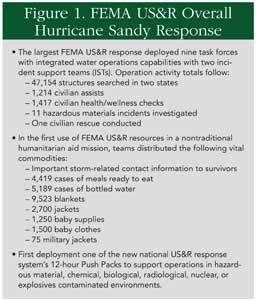 |
Once national US&R resources are committed to support a state’s request for assistance, the IST must ensure that federal resources are committed appropriately in the assigned areas, to save the most lives first, and where they can do the most good with limited resources.
New Jersey. Through the early morning of October 30, as Sandy continued to devastate the coasts of New Jersey, NYS, and states to the north, FEMA received additional requests for US&R task forces from states that were being heavily impacted by the ongoing storm. VA-TF1 and the assigned IST branch director were dispatched to help state and local responders conducting SAR in Little Ferry, Moonachie, and Carlstadt, which were flooded when a storm surge from the Hackensack River inundated their communities. At the time, 500 to 2,000 people were reported to possibly be missing. VA-TF1 supported NJ-TF1 in conducting water environment operations using its watercraft.
VA-TF1 arrived in Little Ferry early on October 30. The Bergen County Office of Emergency Management had set up a forward emergency operations center at a technical school in Teterboro. Local public safety personnel had worked through the night after a tidal surge overwhelmed a levee around the previous midnight, launching from the north of the flooded area in Little Ferry and from the south in Moonachie. The involved agencies and ICs developed a plan in which NJ-TF1 would assume forward operations from the local ICs and manage the rescue/removal of victims still trapped in the flooded areas of Little Ferry and Moonachie. Watercraft and high water vehicles were used to rescue residents, who were brought to several high-ground safe collection points and transported to the technical school for feeding and medical care. They were put in contact with family members with whom they could leave, or they were moved to established shelters. NJ-TF1 worked throughout the morning until relieved by VA-TF1, which worked through the afternoon and into the evening, finishing the grid search of the entire flooded area. Between 5:00 a.m. and 10 p.m., more than 850 individuals were rescued from the flooded area (photos 1-3).
![(1) VA-TF1 personnel aided New Jersey rescue personnel in rescuing stranded victims within a block of the Little Ferry command post, depositing them on dry ground. No personal flotation devices were required since the water was only knee-deep at this point. [Photos courtesy of the Federal Emergency Management Agency (FEMA).]](https://emberly.fireengineering.com/wp-content/uploads/2013/06/collins1-1306fe.jpg) |
![(2) VA-TF1 personnel aided New Jersey rescue personnel in rescuing stranded victims within a block of the Little Ferry command post, depositing them on dry ground. No personal flotation devices were required since the water was only knee-deep at this point. [Photos courtesy of the Federal Emergency Management Agency (FEMA).]](https://emberly.fireengineering.com/wp-content/uploads/2013/06/collins2-1306fe.jpg) |
![(3) VA-TF1 personnel aided New Jersey rescue personnel in rescuing stranded victims within a block of the Little Ferry command post, depositing them on dry ground. No personal flotation devices were required since the water was only knee-deep at this point. [Photos courtesy of the Federal Emergency Management Agency (FEMA).]](https://emberly.fireengineering.com/wp-content/uploads/2013/06/collins3-1306fe.jpg) |
| (1-3) VA-TF1 personnel aided New Jersey rescue personnel in rescuing stranded victims within a block of the Little Ferry command post, depositing them on dry ground. No personal flotation devices were required since the water was only knee-deep at this point. [Photos courtesy of the Federal Emergency Management Agency (FEMA).] |
Two VA-TF1 rescue squads remained in Little Ferry through the night to assist local responders with rescues and other flood-related needs. By sunrise on Wednesday, the floodwaters had essentially receded, and the team was returned to JBMDL.
NYC. Meanwhile, FEMA US&R IST members moved into NYC, where the Fire Department of New York (FDNY) said it needed at least five US&R task forces to assist with wide-area SAR operations in areas where heavy flooding, numerous rescues, and fires had occurred in the teeth of the storm. Many people were feared missing in Queens, the Rockaways, Breezy Point, Staten Island, and surrounding areas. US&R IST Branch VI members reported to the FDNY Incident Command Post (ICP) in Howard Beach at 157th Avenue and Cross Bay Boulevard. FDNY commanders had already divided the worst-hit areas into Breezy Branch, Rockaway Branch, Far Rockaway Branch, and Broad Channel Branch.
FEMA US&R task forces were assigned to search areas designated by FDNY; two IST members coordinated the task force assignments and progress. Many people had stayed in their homes or had tried to escape at the height of the storm, since a growing number of fatalities were discovered. Later a Flushing Division (Flushing Meadows) would be temporarily added until it was determined that there was no need for US&R task forces there.
MD-TF1 was initially assigned to the Rockaways along with PA-TF1; MA-TF1 was also assigned to New York City. FDNY command assigned MD-TF1 to work with FDNY personnel on door-to-door searches in the Howard Beach area east of Cross Bay Boulevard, a road connecting the mainland to the Rockaways. Personnel were not to make forced entry unless there was obvious probable cause (e.g., signs of victims inside). Before FEMA US&R personnel arrived, FDNY personnel were allowed to force entry to completely clear buildings, but that order was later rescinded because of the inability to place New York Police Department personnel at each building where forced entry was accomplished.
MD-TF1 set up its base of operations (BoO) east of Cross Bay Boulevard just south of 157th Avenue. The FDNY ICP was mapping the search area and tracking each team to make sure every house was searched. Essentially, the FEMA US&R task forces and FDNY personnel divided up their assigned areas and systematically worked through them. If FEMA personnel found a residence that needed forcible entry, FDNY personnel would perform it and coordinate securing the building.
MA-TF1 arrived a few hours after MD-TF1 and was assigned to the west side of Howard Beach to assist FDNY personnel in door-to-door searches. Completing this area, they continued working south and searched the Broad Channel area, working until approximately 3:00 a.m.
VA-TF2 arrived in the early evening and was assigned to continue searching the Howard Beach and the Broad Channel areas with FDNY personnel, which was completed at approximately 5:00 a.m. the next day.
Operations continued through the night. This area was accessible in most areas, and the water had receded in all but the lowest lying areas. Because of the amount of searching needed, all task forces worked all of their personnel instead of splitting the task force and thus essentially worked around the clock for several days (photos 4-7).
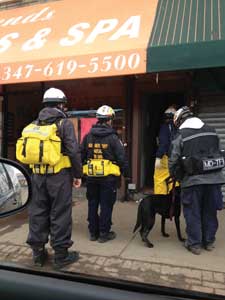 |
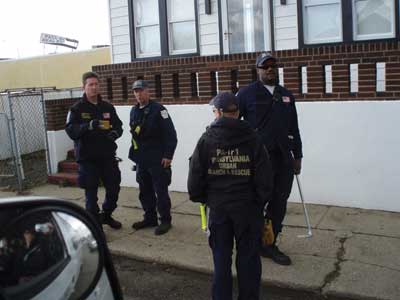 |
| (4-5) MD-TF1 and PA-TF1 searching the Rockaways. |
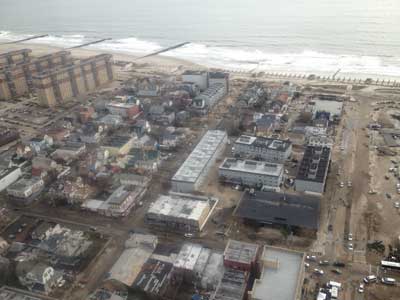 |
| (6) An aerial view of Rockaway Beach during IST recon. |
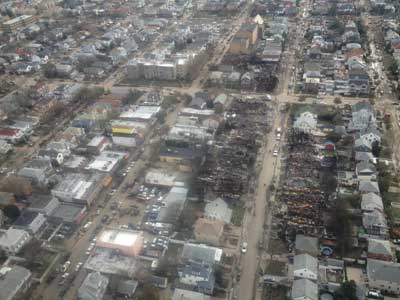 |
| (7) Fires are a danger even during flood disasters. In Rockaway, this is one of several fire zones. |
Nassau County, NY. In the morning, Nassau County requested two FEMA US&R task forces to assist in wide-area SAR operations. Normal communications are often knocked out during hurricanes, and there was little information from adjacent Suffolk County, which occupies eastern Long Island. (This was reminiscent of Hurricane Katrina operations in 2005, when IST members operating in Harrison County, Mississippi, realized nothing had been heard from adjacent Hancock County. IST members and VA-TF2 were dispatched there and discovered some of the worst devastation in areas that had become isolated with no communication. Multiple US&R task forces operated there for more than a week.)
Two IST members, along with PA-TF1 and later IN-TF1, were reassigned from NYC to Nassau County to obtain situational awareness and determine the scope of damage and operations needed. An IST member became the Nassau division supervisor.
The NYS Fire Marshal’s office had deployed two liaisons to Nassau County to coordinate the state US&R team NY-TF2 and the federal US&R resources. With darkness coming on, the ISTs contacted the task forces and the AHJ at the Nassau County Emergency Operations Center (EOC). Local officials indicated possible Hurricane Katrina-like devastation along the coast (photo 8).
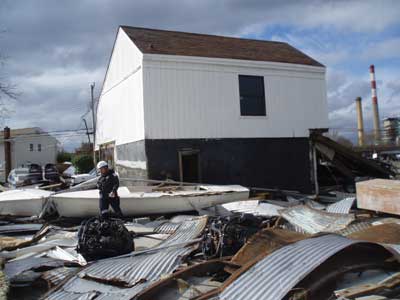 |
| (8) Typical inundation damage found in Nassau County. |
The initial assignment the AHJ described to the ISTs and the NYS Fire Marshal representatives was a search of most of the Nassau County South Shore from the shore a few miles north to Sunrise Highway-a deceptively large, densely populated area that would have taken many days to search even with a half dozen more US&R task forces.
After meeting with the AHJ, the IST established a BoO at the Nassau County Public Safety Center (with combined dispatch and administrative offices) in Westbury. Both US&R task forces set up for multioperational period search operations. At the same time, the NYS fire marshal representatives polled all of the fire departments along the Nassau County shore, asking the chiefs to specify the zones where homes and other buildings had gone underwater. This helped establish more accurate search zones and meet the needs of the AHJs. One IST member arranged for an early morning helicopter recon for October 31 to help gauge the full scope of US&R operations that would likely be required.
The search operation rules of engagement needed to be worked out with Nassau County officials to ensure that the way in which the search was conducted and documented would meet the AHJ’s needs. NYS assumed responsibility for these rules, which provided the following:
- Forcible entry for waterlogged but otherwise undamaged structures was allowed with law enforcement presence and when conditions (e.g., missing occupants, signs of victims possibly inside, high water lines in areas where residents were reported to have stayed) dictated such entry.
- No spray paint or sticker markings were to be made on waterlogged but otherwise undamaged structures.
- Any local resident task forces encountered must complete a resident accountability form.
- If any bodies were discovered, the local coroner’s office and law enforcement agency would be notified.
- The local fire department would respond to 911 calls for occupants needing immediate medical assistance.
- Health and welfare issues would be referred to appropriate authorities.
- Search squads would be tracked by global positioning systems to create search trails to ensure no areas were overlooked.
In the meantime, PA-TF1 and IN-TF1 were conducting windshield recons of the impact area to get better situational awareness on the ground and to scout for possible forward BoO locations.
OCTOBER 31
In New Jersey, VA-TF2 was assigned to SAR operations related to the Hackensack River flooding. In Connecticut, officials were still determining whether FEMA US&R task forces might be needed. NYC operations seemed to be the most dynamic, with multiple concurrent operations ongoing in the Rockaways, on Staten Island, and in Queens. Operations in Nassau County were just beginning, but they would become equally as dynamic.
A FEMA US&R IST liaison officer and the IST deputy operations chief arrived in Branch VI at the NYC EOC at 10:30 a.m. and met face-to-face with the Branch VI director to get his assessment of the US&R operations and anticipated needs supporting NYC. The liaison officer then proceeded to the NYC EOC.
NYC. At 9:00 a.m., October 31, an FDNY IMT formally assumed command and, at an operational briefing, assigned MD-TF1 and MA-TF1 to Rockaway and Far Rockaway and VA-TF2 to Staten Island for door-to-door searches with FDNY personnel. They worked until approximately 9:00 p.m. Additional IST members arrived and were assigned the following morning to Staten Island.
On November 1, the three task forces and the IST members were assigned to continue door-to-door searches along with FDNY personnel on Staten Island. They continued to work until approximately 9:00 p.m., after which FDNY officially released the task forces and IST personnel since the search operations were completed in NYC. The US&R task forces and IST personnel returned to JBMDL in New Jersey for reassignment.
Nassau County. At the BoO in Nassau County, IN-TF1 and PA-TF1 members were mapping out the newly identified search areas. Search operations had already begun in the first targeted areas. The search team managers, task force leaders, and IST continued working together to clarify the grid search assignments. With many inlets, bays, and fingers of land extending to the coast and the barrier islands (and many cities and towns within), the search area in Nassau County would not be contiguous as would be a straight coastline. Rather, the IST, task force leaders, and plans elements agreed to identify these search areas as numbered segments within the division (photos 9-10).
 |
| (9) IST member and US&R task force leaders map Nassau County search areas. |
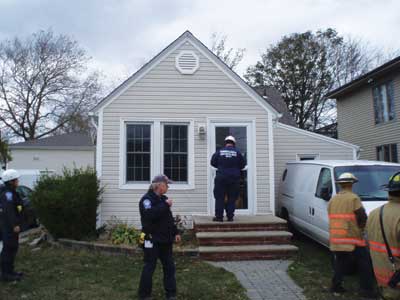 |
| (10) PA-TF1 personnel conduct grid searches in New York City. |
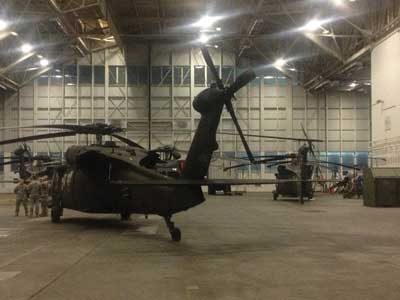 |
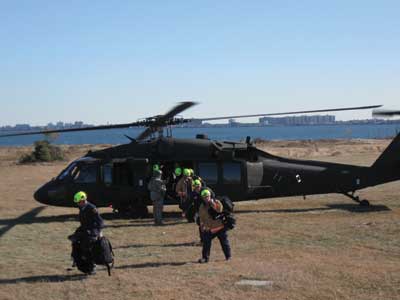 |
| (11-12) Helicopters allowed aerial reconnaissance and personnel movement and provided other services. |
That morning, the IST Nassau Division supervisor and a member of the NYS Fire Marshal’s Office conducted the aerial recon of Nassau County’s coast in a police helicopter. They later briefed the deputy IST operations chief of the day’s recon operations, including the mapping and gridding of numbered segments for the search plan.
Additional help would be needed. Two FEMA US&R task forces assisting a state US&R task force would not be enough to search the huge areas local fire chiefs had identified as having gone underwater, stretching from one end of the Nassau County coast to the other. By the time the search operations were completed, FEMA deployed six US&R task forces for multiple operational periods (two of the task forces would be flown in and out each day from JBMDL) to Nassau County.
MO-TF1, TN-TF1, and two IST members were assigned to Nassau County to assist with search operations. The two additional task forces were integrated into the search plan, and the US&R logistics personnel prepared for the arrival of additional task forces at the BoO.
A US&R IST Air Branch had been established to support all the US&R operations. The FSARCG had coordinated the request to commit helicopters to the New Jersey/New York US&R operations. Initially, two National Guard UH-60 helicopters were placed at the disposal of the US&R resources. The helicopters were used to conduct additional aerial damage assessments and to expedite the movement of US&R personnel and equipment (photo 11-12).
| Figure 2. FEMA US&R Operations |
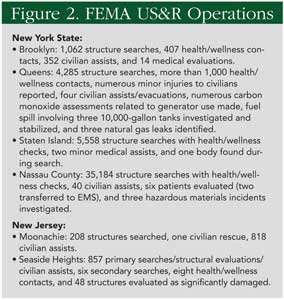 |
NOVEMBER 1-2
New Jersey. FEMA US&R resources were assisting the state of New Jersey and NJ-TF1 in conducting grid searches in several towns along the Jersey Shore. The severe storm surges left so much devastation that only house-by-house canvassing of flooded areas would ensure that no one had been left behind.
Nassau County. Four FEMA US&R task forces were deployed in coastal towns that were reeling from the damage, without electricity, communications, and heat in winter conditions with a large nor’easter approaching in a couple of days. Even where structures were intact, if they had gone underwater and residents or neighbors did not indicate otherwise, each one had to be checked to ensure that no one was still in need of immediate assistance-or worse.
The FEMA US&R Air Branch operated out of JBMDL using National Guard helicopters (designated Task Force Guardian) to provide crew transports, aerial reconnaissance, and other tasks. That morning, Task Force Guardian picked up officials at Republic Airport in Farmingdale to conduct an aerial damage and search area assessment.
The west to east flight over the shore revealed that the worst damage began in the New Jersey/New York area and gradually lessened to the east. The damage and inundation that had hammered the Jersey Shore and NYC was surprising even from the air. There was significant evidence of storm surge flooding across much of the Nassau County shore, where US&R task forces were searching, but Suffolk County appeared to have escaped the worst of it. This confirmed that the search operations were targeting the correct areas and that there did not appear to be additional areas of devastation that weren’t on the radar of the states or the FEMA US&R IST.
The growing number of FEMA US&R task forces and IST personnel in Nassau County required relocating the BoO from the Nassau County Public Safety Building to Hicksville High School, a few miles east, to accommodate all the personnel, equipment, vehicles, and other needs. IN-TF1 agreed to set up expanded shower facilities at the high school (photo 13).
 |
| (13) A high school gym used for sleeping area for US&R task forces. |
Each morning at first light, the US&R task forces moved out into their assigned numbered search segments. Although the searches were progressing, the breadth of the areas still left to be searched made it evident that additional resources were needed. Since search operations had concluded in NYC and the US&R task forces and IST personnel now staged at JBMDL, the IST assigned MD-TF1 and VA-TF2 to assist with the Nassau County search operations. However, there wasn’t sufficient room even at the larger BoO for 160 more personnel and two vehicle convoys. Task Force Guardian shuttled the task forces into Republic Airport each morning and flew them back to JBMDL each night. The Air Branch coordinated with Task Force Guardian to begin flights the next morning (November 3). The NYS fire marshal liaison officers arranged with local Nassau County fire departments to provide buses to transport the task forces to the search areas and back to the airport each day.
With all these operations proceeding, additional US&R IST members, along with an IST equipment cache and support personnel from the National Geospatial Agency (NGA), reassigned from operations in NYC and elsewhere, arrived at the BoO. Their presence and expertise were becoming more important in this most far-flung Division of the federal US&R mission, which, because of the incredible storm damage, had been operating without electricity, Internet (except for limited satellite and portable personal “hot spot” service), hardline phone service, and reliable cell phone service (coverage was still poor in most of Nassau County), and a significant search mission still had to be completed.
At a November 2 evening meeting with a US&R liaison officer, IST members were informed of some new search priorities on the eastern part of the Nassau County shore. The IST members returned to the BoO and reviewed the search plans for the following day with the US&R task force plans and task force leaders. They decided to target those areas by using MD-TF1 and VA-TF2, allowing the original four task forces to continue searching forward from where their operations had concluded that day to maintain consistency and situational awareness (photo 14).
 |
| (14) An operations briefing at the Nassau County BoO. |
So VA-TF2 and MD-TF1 were scheduled to start searching those targeted eastern Nassau County coastal segments. It was anticipated that they would begin to meet the other four task forces in the middle, which would provide wider and faster coverage of the overall search area while addressing the priorities expressed by local officials and fire chiefs. This was briefed to the task forces in Nassau County, and the same information was transmitted to Branch VI, MD-TF1, and VA-TF2 at JBMDL.
At that meeting, other contingencies reviewed included what was known of a new humanitarian assistance mission task that was developing. This emphasized the dynamic nature of this disaster and its many moving parts and the need to maintain maximum flexibility.
HUMANITARIAN MISSION
With the misery quotient high for residents, and with conditions worsening for those in parts of NYC still without power and lacking sufficient fuel, heat, transportation, food, and water, a humanitarian crisis was looming unless it could be preempted by aggressive actions. The storm had overwhelmed some of the normal and disaster systems providing basic needs. Federal, state, and local agencies had for years recommended citizens stock enough food, water, and other essentials to last for up to two weeks in case of such a disaster. Those who ordinarily struggle to meet daily needs suffer the most when a disaster strikes. That was happening now.
Yet even in places where people were able to stock food, water, and other supplies and had generators and other tools ready for a disaster, the storm surge had wiped out their homes and their backup supplies. The unavailability of fuel made this worse where there were no backup generators to run pumps or where generators had been flooded.
So, the national US&R response system, already deployed in the New York/New Jersey area, was asked to assist with humanitarian aid in the hardest-hit areas. The deployed US&R task forces’ sponsoring agencies unanimously agreed to take on this otherwise nontraditional mission. Search operations were still ongoing in the Jersey Shore and Nassau County areas. The FEMA US&R Branch and Task Force Guardian undertook a major operation to assist the NYC OEM with a multipronged humanitarian mission. This had become a priority at the highest levels of federal, state, and local governments.
NOVEMBER 3
Nassau County. Just after daybreak, the four ground task forces continued with their assigned search segments, joined by the task forces flown in from JBMDL. The task forces methodically searched the numbered segments, with IST members helping to coordinate as the segments were completed. By communicating with each other in the field and with the BoO, they filled in the gaps to ensure maximum search coverage to finish the search operations in Nassau County. By noon, 80 percent of the total Nassau County search areas were covered; the IST was confident that search operations could be completed early in the next operational period.
At that night’s IST conference call with the other ISTs in Herndon, Virginia, and at JBMDL, the humanitarian mission update included parameters on canvassing assigned areas of hard-hit NYC neighborhoods along the coast to conduct wellness checks. Force protection for the task forces had been tripled, and most of the IST moved from Herndon to JBMDL to assist in the humanitarian mission. Task Force Guardian and the IST Air Operations Branch were strengthened to support the new humanitarian mission, and US&R task force personnel were flown from JBMDL to Floyd Bennett Field in Queens and back to JBMDL each night. Flying personnel in maximized operational time on the ground; vehicle convoys would face major traffic delays and burden the already gridlocked traffic in the disaster area. US&R task force vehicles were pre-positioned at the Floyd Bennett Field BoO to transport task force personnel and commodities. The humanitarian mission contingencies included health and wellness checks; distribution of important disaster relief information, food, water, cold weather clothing, and blankets; emergency pharmacy refills; and other tasks that may develop. The mission was expected to last two to three days (photo 15).
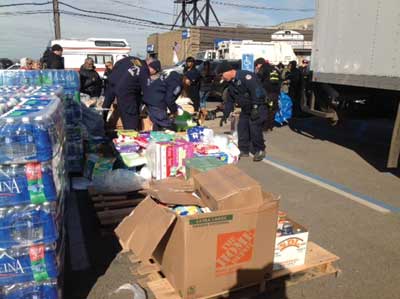 |
| (15) US&R personnel humanitarian operations. |
US&R task forces assigned to the humanitarian mission operated in the Rockaways, Staten Island, and Coney Island, each of which would be a US&R Division and would have a command post established by NYC’s OEM. There were two shifts that had the task forces bedding down and rehabbing at JBMDL each night. As US&R task forces completed search operations, they were moved to JBMDL to join in the humanitarian mission. The Nassau County IMAT initially wanted to retain one US&R task force there as a contingency for the nor’easter storm forecast in two days but agreed to release all Nassau County task forces with the stipulation that one be assigned as a contingency US&R task force at JBMDL. Details were worked out.
NOVEMBER 4
Nassau County. For the last time during this response, the four US&R task forces resumed their assigned search operations. Part of each task force remained to break down the BoO and restore Hicksville High School to its previous condition. MD-TF1 and VA-TF2 returned and continued their numbered search segments. The IST broke down the BoO at Hicksville High School and by 1030 hours had moved to a temporary daytime BoO at the Nassau County Public Safety Building.
By midday, most of the numbered search segments had been completed. The search groups and task forces coordinated to ensure that the search was 100 percent completed as MD-TF1 and VA-TF2 were being decontaminated and transported back to JBMDL.
At 1630 hours, the Nassau Division search operations were completed. The US&R task forces searched more than 41,000 residential and commercial structures in the county and initiated 40 civilian assists that included a variety of special needs. US&R task force members (emergency medical technicians, paramedics, and physicians) conducted prehospital evaluations of 10 patients, two of whom required emergency medical care and were transferred to the care of local EMS personnel for treatment and transport to hospitals. They encountered three hazardous materials incidents that they reported to local authorities, who responded in emergency mode. Several specific “health and wellness contacts” were conducted based on third-party reports. The US&R task forces conducted multiple structural assessments of damaged structures based on requests from local fire departments. The US&R task forces and IST members were released to convoy to JBMDL for reassignment or release.
NOVEMBER 5
Nor’easter Contingency Plan. As most IST members were debriefing in Herndon prior to release from the mission and as most of the US&R task forces were demobilizing, a contingency plan for the incoming nor’easter was being developed. A “quick-reaction force” was needed because of all the damage from Sandy (with the remaining potential for structure collapses, dam failures, levee breaks, and so forth) and the potential for the nor’easter to trigger additional adverse events.
PA-TF1 (then participating in the humanitarian efforts in NYC) would remain mobilized at JBMDL as a contingency task force for response to New York or New Jersey during the nor’easter event, supported by IST elements including the Air Branch, the IST BoO, and command in Herndon. Task Force Guardian helicopters would transport PA-TF1 if conditions allowed, or the team would respond by ground convoy to incidents requiring US&R response in New York or New Jersey.
NOVEMBER 6
PA-TF1 was still finishing up with humanitarian mission operations in NYC, thereafter returning to JBMDL before the nor’easter’s effects began shutting down transportation and other operations. Similarly, Task Force Guardian used the remaining time before the storm to conduct various minor transport flights. Then all aircraft were secured in hangars, all flights discontinued, and PA-TF1 and IST elements went on standby as the nor’easter approached and passed through New Jersey with moderate to heavy snow, winds, and deteriorating conditions along the coast.
NOVEMBER 7
PA-TF1 and Task Force Guardian remained on standby at JBMDL as the nor’easter passed through New Jersey. After the snowfall ended and the winds diminished, the JBMDL tarmacs and roads were cleared of snow. Task Force Guardian aircraft were removed from hangars and readied for any flights needed to support the US&R contingency. While on standby, PA-TF1 and Task Force Guardian personnel conducted aircraft loading drills onto the helicopters and cargo planes.
NOVEMBER 8
Preparations were in progress to demobilize PA-TF1, the IST, and Task Force Guardian. The Air Operations Branch was closed out, and Task Force Guardian aircraft were released to their home bases. But just before noon, the IST was informed that PA-TF1 and the IST were being reassigned to help establish a beachhead for a likely new humanitarian mission in New York City. They were assigned to report to the IMAT in New York, specifically to the branch director at a joint ICP in the Rockaways. PA-TF1 convoyed to Floyd Bennett Field and began establishing a BoO to prepare for a possible additional humanitarian mission that would require an unknown number of US&R task forces.
The additional humanitarian mission, a high priority on the federal, state, and local governments’ lists, was to help NYC conduct “smart searches” and basic needs assessments for all residents of buildings four stories or higher in the Sandy-impacted area of the city, mostly in Queens. Coordinated multiple agencies and resource types would move independently through the areas to determine the follow-up needs of these residents and to identify and treat immediate health and EMS situations.
NGA analysis estimated that there were at least 1,600 structures higher than four stories. This significant undertaking required multiple US&R task forces to operate for multiple days with significant force protection, ambulances, and possibly other support like mobile pharmacy supplies, food, and water.
At the joint ICP, commanders highlighted the importance of operational consistency for reliable results. Since US&R task forces had already been similarly occupied in their recent search and humanitarian missions, it seemed natural for US&R resources to work this nontraditional humanitarian mission.
IST members conservatively estimated it would take 15 minutes per visit for each occupied residence in 1,600 buildings (well over 20,000 individual apartments, perhaps more). As for force protection, they assumed that two officers (one at each end of a hallway) were required per floor searched and at least two or more to secure task force vehicles and supplies at ground level. They began estimating those numbers as well.
Which agencies would carry out these operations had not yet been decided, nor had the city’s OEM or the Mayor’s Office finalized the rules of engagement. But the IST proactively began estimating how many US&R task forces would be needed, the support they required, and other preparation activities. PA-TF1’s leaders and plans and search team managers used the data to begin establishing the search divisions and branches needed.
NOVEMBER 9
The IST and PA-TF1 continued making preparations for the possible additional humanitarian mission. The operations section chief arrived and was briefed along with other IST members arriving at the IMAT Branch. FEMA’s US&R branch chief and US&R branch operations section chief later arrived and consulted with the IMAT. Meanwhile, PA-TF1 had completed a preliminary tactical action plan and readied search planning maps. Task force personnel were on standby at Floyd Bennett Field.
In midafternoon, the IST was informed that the FEMA US&R task forces would not be needed for the additional humanitarian mission and that other resources would be assigned to conduct the wellness checks. All FEMA US&R resources were demobilized that afternoon and the following day.
Author’s note: Thanks to Fred Endrikat, FEMA US&R branch chief, for his assistance with this article.
LARRY COLLINS is a battalion chief and 33-year veteran of the Los Angeles (CA) County Fire Department. He is a task force leader of the Los Angeles County Fire Department’s Urban Search and Rescue Team (CA-TF2/USA-2). Collins was assigned as deputy operations chief of the FEMA US&R Incident Support Team (IST) during the Hurricane Sandy response.
Fire Engineering Archives

